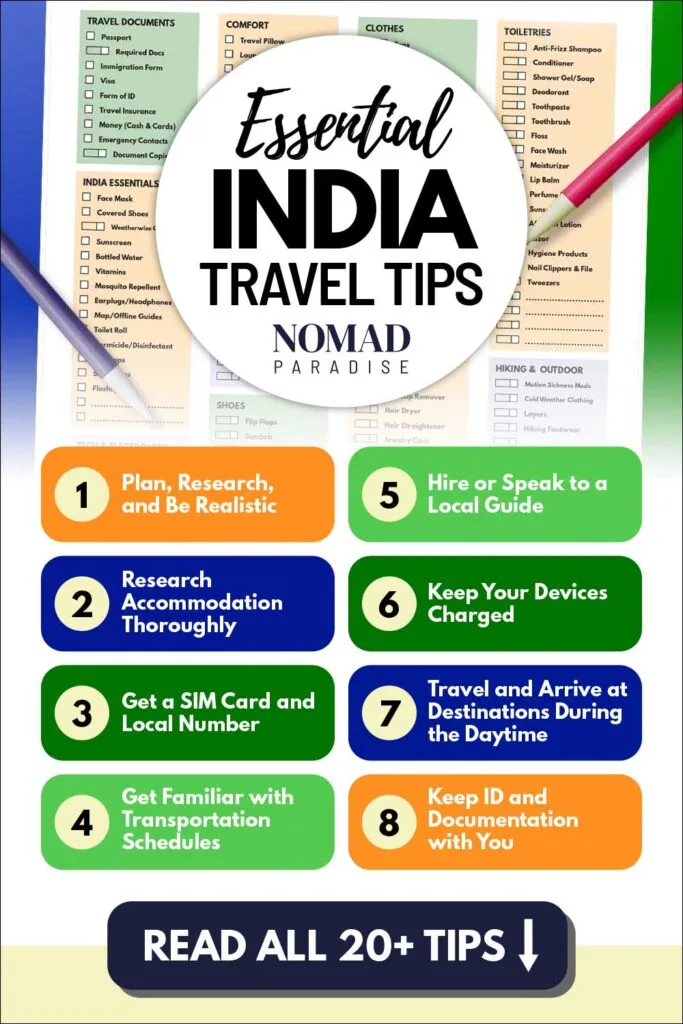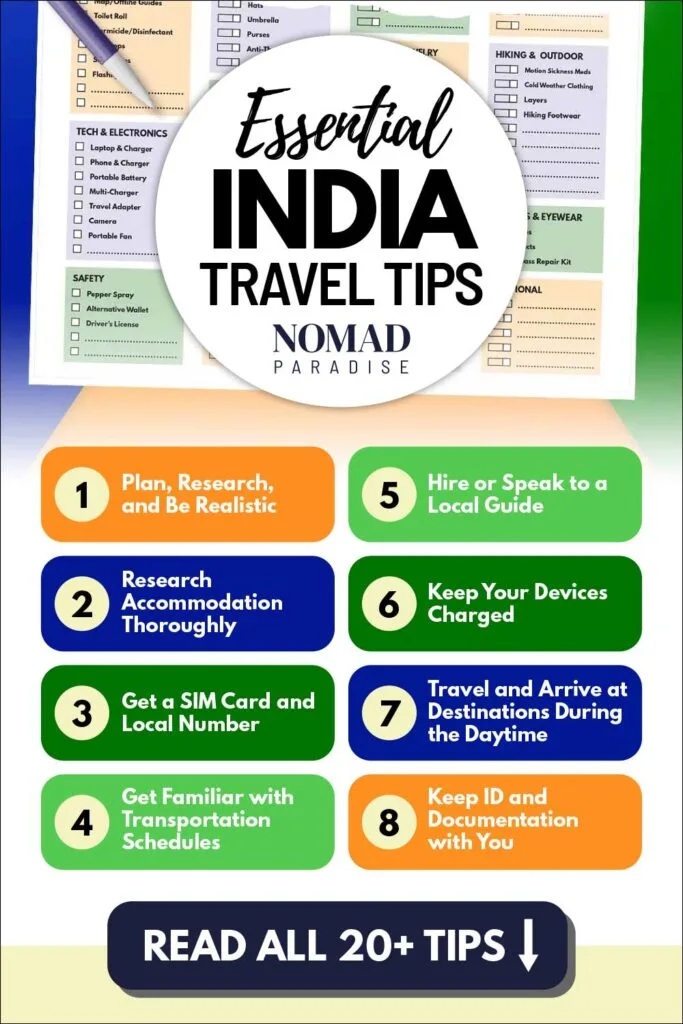This website may contain affiliate links and advertising so that we can provide recipes and guides at no additional cost to you. Learn more
Preparing for a vacation or trip to India and eager to leave no stone unturned? Use our India travel tips, in addition to our India packing list, to educate yourself about traveling to this vast and bustling country.
While India is very much a ‘once-in-a-lifetime’ destination for so many people, and it promises to enthrall, inspire, and awe with its color, food, culture, and beauty, it is very important to be knowledgeable about customs, climate, and staying safe before you travel.
Featuring invaluable insight from a local, you can use this article and our packing list to pack and plan with safety, comfort, and know-how at the forefront. Be proactive, get informed, and enjoy a far more enjoyable trip further down the line when it’s time to go.
India Travel Tips

1. Plan, Research, and Be Realistic
India is a huge country with a lot to see, eat, and experience. So, do your research and plan your trip accordingly. Figure out what you want to see, where you want to go, how to get there, and how much it will cost.
Some of the more popular destinations may be hours away from major cities or airports, so you need to know how feasible your itinerary actually is.
2. Research Accommodation Thoroughly
Make sure the place you choose to stay at is safe, well-connected, and reasonably priced. While it is always best to stay at well-established, well-known hotels and resorts, sometimes they cost too much.
Fortunately, there are plenty of reasonable accommodations, like hostels, which can be safe and cost-effective.
3. Get a SIM Card and Local Number
Either get another SIM card just for your travel or get a second phone because you will need a local number. You can usually get local SIMs at the airport, but they will often be cheaper at telecoms or phone stores in malls or markets.
This will help with booking cabs, ride-shares, or even just take-out food. Also, if you are booking or buying things online, a local number will be required to keep track and follow up.
4. Get Familiar with Transportation Schedules
Whether you are traveling by trains, planes, buses, or private transportation, each have their own schedules, locations, and requirements.
If you are traveling by bus, you will need to know your bus schedule. For example, some buses or only for women, and some are on an express route and don’t make all the stops.
Of course, autos (tuk-tuks) and rideshares can be booked online, but sometimes they may not take light night fares or travel too far, so plan ahead.
5. Hire or Speak to a Local Guide
It is common to want to experience India like a local and not just do the touristy things that have been curated for travelers. While the Internet is a fountain of knowledge and information, you need real people with real information to tell you the nitty gritty.
If you know someone locally, get in touch and ask them to help. You could also speak with and hire a qualified, legitimate guide who can help you experience the hidden gems and local experiences of India in a safe, informed way.
6. Keep Your Devices Charged
You don’t always know how long you are going to be out, so always make sure your devices are charged. Some public transportation might not have a charging station on board, so have a portable battery on hand.
You will rely on your devices for everything, from viewing maps to researching unfamiliar words to booking tickets. Also, be sure to pack several travel adapters. India generally uses a 3-pin (type D) round plug.
7. Travel and Arrive at Destinations During the Daytime
It is best when traveling to a new destination to arrive during the daytime. Especially for women travelers, if going someplace unfamiliar, do not travel or arrive at night.
You are far more likely to get lost, be cheated, robbed, or arrive past closing time. Traveling and arriving during the day gives you more time to come up with a backup plan or find help if something goes awry.
8. Keep Copies of Your ID and Documentation with You
Keep a photocopy of your ID with you at all times. It may be necessary in case of an emergency, whether you need to go to a hospital or need help from the police.
9. Be Aware and Follow Local Customs
Important no matter where you are traveling, India has many local and regional customs, and while you don’t need to know all the customs, it is good to at least be aware of them.
Some that are country-wide include the following:
- Never wear shoes inside a temple.
- Never wear shoes inside someone’s home.
- Eating with your hands is acceptable and very common.
- Avoid public displays of affection.
Do your research accordingly, and find out about the specific places and regions you are visiting because some of the customs and expectations are different.
10. Dress Appropriately
India is quite conservative, and it’s better to dress appropriately. While in larger cities and at popular tourist spots, you can generally dress as you wish, in smaller towns and cities, even wearing shorts or sleeveless tops, especially as a woman, can, unfortunately, invite a lot of unwanted attention.
11. Don’t Share Personal Information with Strangers
Most people in India are very friendly and extremely helpful. It is common to run into people who are fascinated by foreigners and will have lots of questions, some of them very intimate and personal.
Be polite and courteous, but do not share personal information with anyone you don’t know, especially if you are a woman traveling alone. Never share personal information or where you are staying, and try not to give too much away about your travel plans and where you intend to go.
12. Don’t Over-Plan, Do What is Possible
There is a lot to see and do in India, and it is impossible to see and do everything. If you really want to enjoy and savor your time in India, leave a little room for spontaneity and taking in the culture.
With the heat, noise, and often unreliable transport schedules (see #17), a packed itinerary with little to no room for adjustment can actually cause far more stress and burnout than enjoyment.
Prioritize the landmarks and experiences you absolutely want to see, and then give yourself time to walk around, try the food, take in the sights, and unwind and relax after a busy day.
13. Research Local Cuisine
Depending on which part of India you are visiting, research what the local cuisine is like. While all cities and cosmopolitan and you should be able to find most types of cuisine and eating options, in smaller towns and cities, if you have allergies or culinary preferences, you might be short on choice.
Many of the holy cities offer only vegetarian foods, as do many hostels and accommodations. Different parts of India use different types and levels of spices, grains, dairy products, and even fruits and vegetables.
Indian food is also renowned for its heat and spice, so if you have a particularly sensitive stomach or food allergies, you need to do your research beforehand about where you can eat.
Related:
- 20 Indian Street Foods for a Spellbinding Taste of India
- 20 Flavorsome Indian Curries You Need To Try
- 15 Types of Indian Dals You Should Try: A Guide to Dals and Dishes Used In
- 20 Indian Snacks to Savor the Heat and Spice in Bite-Sized Form
- 20 Indian Drinks to Quench Your Thirst and Nourish Your Body
14. Carry Anti-Diarrhea Pills
You may need anti-diarrhea pills or something to quell potential nausea, indigestion, and food poisoning. As mentioned above, Indian food, for the most part, is spicy, and authentic Indian food will be unfamiliar to most tourists.
There is a high chance of tourists getting “Delhi Belly,” which is a real thing, or food poisoning. Come prepared, as public toilets aren’t always available, accessible, or sanitary.
15. Always Carry Sanitizer and Toilet Paper
Bidets are widely used throughout the country, so it is best to always have toilet paper (if you prefer to use toilet paper) and sanitizer with you.
In addition, in many parts of India, you may be eating with your hands, so having sanitizer on hand is important.
16. Carry Pepper Spray
Both men and women should carry pepper spray as a precaution. Some parts of India are relatively safe, but other parts can be dangerous, especially if you are traveling alone.
Tourists are an easy target for thieves, so pepper spray will give you some form of protection. Naturally, however, do your research before you travel to a place. Don’t take the risk with some places, unless you are with a large group or guided tour.
17. Be Prepared for Indian Time
Indian Standard Time is real! Be prepared for long waits and late arrivals. While most planes and trains are on time, many other forms of transportation are not as dependable.
People tend to give estimates about time, and it is not uncommon for things to get delayed.
18. Learn to Haggle and Barter
You are going to have to learn to haggle if you are planning to buy anything in India, especially at popular tourist destinations or renowned markets. Whether it is for an entry fee or a souvenir, local merchants tend to hike up the price significantly if they know you are a tourist.
This is also true for autos and cabs. You need to be willing to argue for a cheaper price and even push for as low as half the price. Be aware that you are not being given the actual price and that it likely is a marked-up rate. If you are too shy to haggle, go with a local who can help you.
19. Beware of Pickpockets
Pickpockets are common and notoriously adept at spotting tourists. Popular spots that tend to get large crowds are easy pickings for thieves, so keep your belongings close.
Do not keep your wallet in your back pocket or leave your purse unzipped. Get a fanny pack or a backpack you can wear in front, and consider an anti-theft bag and/or backpack.
Watch out for groups of children in tourist areas, who may be on the lookout for tourists to pickpocket.
20. Be Prepared for Culture Shock
India is beautiful and breathtaking, but it is also overwhelming, especially for first-time visitors. The country is crowded, and it is easy to get swallowed by the sheer number of people.
Remember, India has the second-highest population in the world, with more than 1 billion people. But it is not just the people: the sights, the smells, the local customs, the food, the celebrations, and of course the heat, can be a lot to take in.
So, ease yourself into it. It can be confusing and frustrating, and things might not go according to plan, but the best way to enjoy India is to try your best to go with the flow.
21. Carry Bottled Water
The most important travel tip when going to India is to carry bottled water with you at all times. This is for two reasons: the first being the heat, which means you have to keep yourself constantly hydrated.
The second, which is important to take seriously, is that Indian tap water is not safe to drink. Do not try to filter tap water, and try to avoid asking for water at restaurants if you are unsure where the water has been sourced.
Instead, always have safe, bottled water with you. In India, it is referred to as mineral water, which is available in most stores, restaurants, and pharmacies.
Summary
As with any new destination, but especially India, it is so important to get clued up on the climate, customs, culture, and how to stay safe.
Our list of India travel tips, paired with our India packing list PDF, is an excellent place to start planning your trip to one of the world’s most vibrant and energetic countries.
Put the effort in now. Plan accordingly and conservatively, helping you free time and energy when you actually arrive in India to fully experience the magic of it.
You Might Also Like to Read
- 34 Solo Travel Tips You Need to Know
- 21 Practical Tips for Traveling on a Budget
- The Ultimate Vacation Packing List: 50+ Essentials You Need
Save and Pin for Later
Planning a trip to India in the not-too-distant future? Keep our insightful travel tips for safekeeping by saving this article to one of your planning boards

Contributor: Nandhini Parthib is an Indian content writer, deeply passionate about Indian culture, travel, and cuisine, who is keen to share more about India through her writing.
